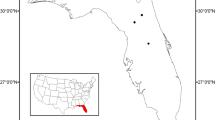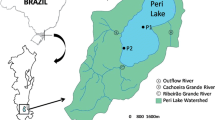Abstract
We explored the use of carbon and nitrogen isotopes (δ13C and δ15N) in sedimented organic matter (OM) as proxy indicators of trophic state change in Florida lakes. Stable isotope data from four 210Pb-dated sediment cores were compared stratigraphically with established proxies for historical trophic state (diatom-inferred limnetic total phosphorus, sediment C/N ratio) and indicators of cultural disturbance (sediment total P and 226Ra activity). Diatom-based limnetic total P inferences indicate a transition from oligo-mesotrophy to meso-eutrophy in Clear Lake, and from eutrophy to hypereutrophy in Lakes Parker, Hollingsworth and Griffin. In cores from all four lakes, the carbon isotopic signature of accumulated OM generally tracks trophic state inferences and cultural impact assessments based on other variables. Oldest sediments in the records yield lower diatom-inferred total limnetic P concentrations and display relatively low δ13C values. In the Clear, Hollingsworth and Parker records, diatom-inferred nutrient concentrations increase after ca. AD 1900, and are associated stratigraphically with higher δ13C values in sediment OM. In the Lake Griffin core, both proxies display slight increases before ~1900, but highest values occur over the last ~100 years. As Lakes Clear, Hollingsworth and Parker became increasingly nutrient-enriched over the past century, the δ15N of sedimented organic matter decreased. This reflects, in part, the increasing relative contribution of nitrogen-fixing cyanobacteria to sedimented organic matter as primary productivity increased in these waterbodies. The Lake Griffin core displays a narrow range of both δ13C and δ15N values. Despite the complexity of carbon and nitrogen cycles in lakes, stratigraphic agreement between diatom-inferred changes in limnetic total P and the stable isotope signatures of sedimented OM suggests that δ13C and δ15N reflect shifts in historic lake trophic state.
Similar content being viewed by others
References
Appleby, P. G. & F. Oldfield, 1983. The assessment of 210Pb data from sites with varying sediment accumulation rates. Hydrobiologia 103: 29–35.
Agustí, S., C. M. Duarte & D. E. Canfield, Jr., 1990. Phytoplankton abundance in Florida lakes: evidence for the frequent lack of nutrient limitation. Limnol. Oceanogr. 35: 181–188.
Binford, M. W. & M. Brenner, 1986. Dilution of 210Pb by organic sedimentation in lakes of different trophic states, and application to studies of sediment-water interactions. Limnol. Oceanogr. 31: 584–595.
Boutton, T. W., 1991. Stable carbon isotope ratios of natural materials: II. Atmospheric, terrestrial, marine, and freshwater environments. In: D. C. Coleman & B. Fry (eds) Carbon Isotope Techniques. Academic Press Inc., New York: 173–185.
Bremner, J. M. & C. S. Mulvaney, 1982. Nitrogen–Total. In: A. L. Page (ed) Methods of Soil Analysis, Part 2, 2nd edition: Chemical and Microbiological Properties. ASA, SSSA. Madison, WI: 595–624.
Brenner M. & M. W. Binford, 1988. Relationships between concentrations of sedimentary variables and trophic state in Florida lakes. Can. J. Fish. Aquat. Sci. 45: 294–300.
Brenner, M., T. J. Whitmore, M. S. Flannery & M. W. Binford, 1993. Paleolimnological methods for defining target conditions in lake restoration: Florida case studies. Lake and Reserv. Manage. 7: 209–217.
Brenner, M., A. J. Peplow & C. L. Schelske, 1994. Disequilibrium between 226Ra and supported 210Pb in a sediment core from a shallow Florida lake. Limnol. Oceanogr. 39: 1222–1227.
Brenner, M., T. J. Whitmore, J. H. Curtis & C. L. Schelske, 1995. Historical ecology of a hypereutrophic Florida lake. Lake and Reserv. Manage. 11: 255–271.
Brenner, M., T. J. Whitmore & C. L. Schelske, 1996. Paleolimnological evaluation of historical trophic state conditions in hypereutrophic Lake Thonotosassa, Florida, USA. Hydrobiologia 331: 143–152.
Brenner, M., C. L. Schelske & T. J. Whitmore, 1997. Radium-226 stratigraphy in Florida lake sediments as an indicator of human disturbance. Verh. Internat. Verein. Limnol. 26: 809–813.
Brooks, H. K., 1981. Guide to the physiographic divisions of Florida. Florida Cooperative Extension Service, Institute of Food and Agricultural Sciences, University of Florida, Gainesville, FL.
Bush, P. W., 1974. Hydrology of the Oklawaha Lakes Area of Florida. U.S. Geol. Survey Map Ser. No. 69.
Canfield, D. E., Jr., 1981. Chemical and trophic state characteristics of Florida lakes in relation to regional geology. Final report to Cooperative Fish and Wildlife Research Unit, Univ. of Florida, Gainesville, FL.
Canfield, D. E., Jr. & M. V. Hoyer, 1992. Aquatic macrophytes and their relation to the limnology of Florida lakes. Final report submitted to the Bureau of Aquatic Plant Management, Florida Department of Natural Resources, Tallahassee, Florida.
Canfield, D. E., Jr., K. A. Langeland, M. J. Maceina, W. T. Haller & J. V. Shireman, 1983. Trophic classification of lakes with aquatic macrophytes. Can. J. Fish. Aquat. Sci. 40: 1713–1718.
Carlson, R. E., 1977. A trophic state index for lakes. Limnol. Oceanogr. 22: 361–369.
Carrick, H. J., F. J. Aldridge & C. L. Schelske, 1993. Wind influences phytoplankton biomass and composition in a shallow, productive lake. Limnol. Oceanogr. 38: 1179–1192.
Danek, L. J., T. A. Barnard & M. S. Tomlinson, 1991. Bathymetric and sediment thickness analysis of seven lakes in the Upper Oklawaha River Basin. Special Publication SJ 91-SP14, St. Johns River Water Mangement District, Palatka, FL.
Duarte, C. M., S. Agustí & D. E. Canfield, Jr., 1992. Patterns in phytoplankton community structure in Florida lakes. Limnol. Oceanogr. 37: 155–161.
Eakins, J. D. & R. T. Morrison, 1978. A new procedure for the determination of lead-210 in lake and marine sediments. Int. J. Appl. Radiat. Isotopes. 29: 531–536.
Fisher, M. M., M. Brenner & K. R. Reddy, 1992. A simple, inexpensive piston corer for collecting undisturbed sediment/ water interface profiles. J. Paleolim. 7: 157–161.
Flannery, M. S., R. D. Snodgrass & T. J. Whitmore, 1982. Deepwater sediments and trophic conditions in Florida lakes. Hydrobiologia 92: 597–602.
Florida Lakewatch, 1996. Florida Lakewatch Data 1986–1996. Department of Fisheries and Aquatic Sciences, Univ. of Florida, Gainesville.
Fogel, M. L., L. A. Cifuentes, D. J. Velinsky & J. H. Sharp, 1992. Relationship of carbon availability in estuarine phytoplankton to isotopic composition. Mar. Ecol. Prog. Ser. 82: 291–300.
Fulton, R. S., III, 1995. External nutrient budget and trophic state modeling for lakes in the upper Ocklawaha River Basin. Technical Publication SJ95–6, St. Johns River Water Management District, Palatka, FL.
Goericke, R., J. P. Montoya & B. Fry, 1994. Physiology of isotopic fractionation in algae and cyanobacteria. In: K. Lajtha & R. H. Michener (eds) Stable isotopes in Ecology and Environmental Science. Blackwell Scientific Publications, Boston: 187–221.
Gu, B. & C. L. Schelske, 1996. Temporal and spatial variations in phytoplankton carbon isotopes in a polymictic subtropical lake. J. Plankton Res. 18: 2081–2092.
Gu, B., C. L. Schelske & M. Brenner, 1996. Relationships between sediment and plankton isotope ratios (d13C and d15N) and primary productivity in Florida lakes. Can. J. Fish. Aquat. Sci. 53: 875–883.
Håkanson, L. & M. Jansson, 1983. Principles of lake sedimentology. Springer-Verlag, New York. 316 pp.
Hodell, D. A. & C. L. Schelske, 1998. Production, sedimentation, and isotopic composition of organic matter in Lake Ontario. Limnol. Oceanogr. 43: 200–214.
Hoyer, M. V., B. Gu & C. L. Schelske, 1997. Sources of organic carbon in food webs of two Florida lakes indicated by stable isotopes. In: E. Jeppesen, Ma. Søndergaard, Mo. Søndergaard & K. Christoffersen (eds) The Role of Macrophytes in Structuring the Biological Community and Biogeochemical Dynamics in Lakes. Springer-Verlag, New York: 326–330.
Huber, W. C., P. L. Brezonik, J. P. Heaney, R. E. Dickinson, S. D. Preston., D. S. Dwornik & M. A. DeMaio, 1982. A classification of Florida lakes. Report ENV-05-82-1 to the Florida Department of Environmental Regulation, Tallahassee, FL.
Huffman, E. W. D., Jr., 1977. Performance of a new automatic carbon dioxide analyzer. Microchem. J. 22: 567–573.
Hustedt, F., 1930–1966. Die Kieselalgen Deutschlands, Österreichs und der Schweiz. In: Dr. L. Rabenhorst's Kryptogamen Flora von Deutschlands, Österreichs und der Schweiz. Band 7. Teil 1–3.
Leslie, A. J., Jr., L. E. Nall & J. M. Van Dyke, 1983. Effects of vegetation control by grass carp on selected water quality variables in four Florida lakes. Trans. Am. Fish. Soc. 112: 777–787.
McKenzie, J. A., 1985. Carbon isotopes and productivity in the lacustrine and marine environment. In: W. Stumm (ed) Chemical Processes in Lakes. Wiley, New York: 99–118.
Oldfield, F. & P. G. Appleby, 1984. Empirical testing of 210Pb-dating models for lake sediments. In: E. Y. Haworth & J. W. G. Lund (eds) Lake Sediments and Environmental History. U. Minn. Press, Minneapolis: 93–124.
Peterson, B. J. & B. Fry, 1987. Stable isotopes in ecosystem studies. Annu. Rev. Ecol. Syst. 18: 293–320.
Patrick, R. & C. W. Reimer, 1966–1975. The Diatoms of the United States. Monogr. Acad. Sci. Phila., No. 13, Part 1, v. 1–2.
Schelske, C. L., A. Peplow, M. Brenner & C. N. Spencer, 1994. Low-background gamma counting: applications for 210Pb dating of sediments. J. Paleolim. 10: 115–128.
Schelske, C. L., D. J. Conley, E. F. Stoermer, T. L. Newberry & C. D. Campbell, 1986. Biogenic silica and phosphorus accumulation in sediments as indices of eutrophication in the Laurentian Great Lakes. Hydrobiologia 143: 79–86.
Shannon, E. E. & P. L. Brezonik, 1972. Limnological characteristics of north and central Florida lakes. Limnol. Oceanogr. 17: 97–110.
Stewart, H. G., 1966. Groundwater resources in Polk County, Florida. Florida Geol. Surv. Rep. Investigation 44. Florida Dep. Nat. Resour. Bur. Geol., Tallahassee.
Stiller, M. & M. Magaritz, 1974. Carbon-13 enriched carbonate in interstitial waters of Lake Kinneret sediments. Limnol. Oceanogr. 19: 849–853.
Van der Werff, A., 1955. A new method of concentrating and cleaning diatoms and other organisms. Int. Ver. Theor. Angew. Limnol. Verh. 12: 276–277.
Whitmore, T. J., 1989. Florida diatom assemblages as indicators of trophic state and pH. Limnol. Oceanogr. 34: 882–895.
Whitmore, T. J., M. Brenner & C. L. Schelske, 1996. Highly variable sediment distribution in shallow, wind-stressed lakes: a case for sediment-mapping surveys in paleolimnological studies. J. Paleolim. 15: 207–221.
Author information
Authors and Affiliations
Rights and permissions
About this article
Cite this article
Brenner, M., Whitmore, T.J., Curtis, J.H. et al. Stable isotope (δ13C and δ15N) signatures of sedimented organic matter as indicators of historic lake trophic state. Journal of Paleolimnology 22, 205–221 (1999). https://doi.org/10.1023/A:1008078222806
Issue Date:
DOI: https://doi.org/10.1023/A:1008078222806




